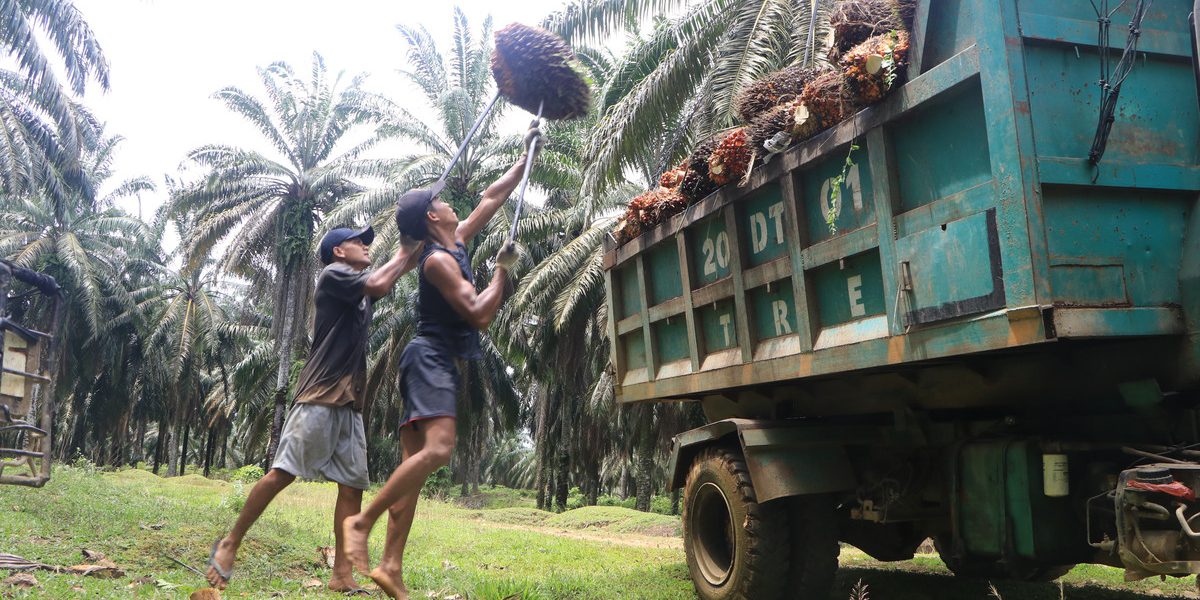The national palm oil industry is not doing well. Production declined four this year. The target of 90 million tonnes in 2045 is far from over. The main culprits are stalled rejuvenation, trade barriers and domestic policies.
The national palm oil industry is not in good condition. Palm oil production has decreased by four years to 46.72 million tons in 2022. The target of 90 million tons per year by 2045 is far from being achieved. The cause of this is the declining productivity due to aging crops and stagnated rejuvenation. Trade barriers abroad and domestic policies are also challenges.
Chairman of the Indonesian Palm Oil Association (Gapki) Eddy Martono, in a discussion with the media in West Bandung Regency, West Java, Wednesday (23/8/2023), said that Indonesia is still a producer of crude palm oil (crude oil). largest palm oil/CPO) in the world. In 2022, the palm oil industry will contribute US$39.07 billion in foreign exchange or around IDR 600 trillion. However, various challenges faced amid the decline in production.
“The national palm oil production has peaked and is currently on a declining trend. We must avoid the same fate as the national sugar industry, which was once the second largest in the world but then suffered due to inappropriate and non-conducive policies,” said Eddy.
Eddy stated that the main cause of the decline in national palm oil production is due to the increasing composition of old plants in smallholder palm plantations. Meanwhile, the smallholder palm rejuvenation program (PSR) initiated by the government and funded by the Oil Palm Plantation Fund Management Agency (BPDPKS) is not meeting expectations.
The government targets to expand the Peoples Plantation Scheme (PSR) to 185,000 hectares per year. However, the actualization is only 25,000-30,000 hectares per year, which is only 16 percent of the target. This condition causes the productivity of smallholder palm oil plantations to decrease each year.
However, the presence of smallholder palm oil plantations is very significant in the national palm oil industry. Based on an audit by the task force for the governance of the palm oil industry established by the government, the area of smallholder palm oil plantations reaches 6.4 million hectares or 38 percent of the total 16.8 million hectares of palm oil plantations in Indonesia. The remaining 10.4 million hectares are company-owned plantations.
The Head of Foreign Affairs Department of the Indonesian Palm Oil Association (Gapki), M. Fadhil Hasan, explained that the only way to increase national palm oil production is through productivity improvement. Expanding the plantation area is not possible because the government has implemented a moratorium on opening new palm oil plantations.
“If we can increase the production of smallholders’ palm oil by 0.5 tons of CPO per hectare per year, the increase in land area will already reach 3.2 million tons,” said Fadhil.
However, the potential for improving the productivity of smallholder palm oil farmers is far greater than that. Currently, the average productivity of smallholder palm oil farmers is only 2 tons of crude palm oil per hectare per year, far less than the productivity of companies that already produce 4-8 tons of crude palm oil.
Observing the stagnant rejuvenation of the people’s palm oil and declining national CPO (Crude Palm Oil) production, it seems that this trend may continue. This can be seen from the average growth rate of Indonesia’s CPO production which has slowed down since 2010.
During the 2005-2010 period, national CPO production growth reached 10.12 percent per year, then slowed to 7.39 percent in 2010-2015, and slowed again to 3.2 percent in 2015-2020. In the 2020-2025 period, national CPO production growth has become negative at 1.15 percent.
CPO production has decreased over the past four years after reaching a peak in 2019 at 51.8 million tons. The decline began in 2020 with only 47.03 million tons, followed by 46.88 million tons in 2021, and 46.72 tons in 2022. “Our national palm oil industry is currently facing declining production coupled with rising production costs,” said Fadhil.
With this situation, Indonesia needs to anticipate fierce competition in the world’s vegetable oil market. Although the market share of palm oil is still the largest in the vegetable oil industry, its ownership is only 33 percent. This market share could decline due to an increase in production of other vegetable oils. This could pose a serious threat to the national palm oil industry.
Government policy
Eddy stated that government policy also greatly determines the future of the palm oil industry. Gapki supports the improvement of the national palm oil industry governance currently being developed by the government, led by Coordinating Minister for Maritime Affairs and Investment, Luhut Binsar Pandjaitan.
However, the government must show a bias towards the salvation of the national industry. Eddy cited the government’s move in 2022 to temporarily halt the export of CPO to address the supply shortage and skyrocketing prices of cooking oil.
According to Eddy, the export ban was a tragic situation. “It happened during Eid al-Fitr when CPO production was at its peak. Storage tanks at the factory were already full, and even tanker ships were being used for storage. As a result, the factories were unable to accept fruit from farmers, causing lots of fruit to rot on trees,” Eddy said.
However, at that time the price of CPO (Crude Palm Oil) was high due to the inability of sunflower seed oil to be exported from Russia and Ukraine because of the war. Nevertheless, Indonesia did not benefit from the price increase due to the export suspension. Meanwhile, the price at the farmer level dropped drastically, while farmers in other producing countries enjoyed soaring prices.
Eddy stated that Gapki supports the government’s proposed management of the palm oil industry, particularly in regards to the whitening or legalizing process for 3.3 million hectares of palm plantations in forest areas. However, the narrative should not corner the national palm oil industry.
“The bleaching of HGU (cultivation rights) in forest areas does not mean that the company is forgiven by the government. Oil palm companies get HGU certificates from the government legally after the status of the land is clear and clean (clean and clear),” said Eddy.
At the end of June, Luhut said an audit of the palm oil industry governance task force found 3.3 million hectares of oil palm cover in forest areas. “Palm plantations in the area will be bleached. What else do you want? It can’t be repealed because it has to be bleached,” Luhut said at a press conference at his office, in Jakarta (Kompas.id, 24/4/2023).
As a follow-up, the government requested companies to independently report company data, which includes general information, legality, legal products, and company licenses through the Plantation Licensing Information System (Siperibun) website on July 3 – August 2, 2023, which was then extended on August 23 – September 8.
Luhut stated that the issue of palm oil plantations in forest areas will be resolved through two schemes, namely Article 110A and 110B of Law Number 6 of 2023 concerning Job Creation.
Anti-deforestation Law
Faculty member of the Faculty of Economics and Business at the University of Indonesia, Eugenia Mardanugraha, stated that the Indonesian palm oil industry will also face trade barriers in the coming years. The latest potential trade barrier is the Anti-Deforestation Law (EU Deforestation Regulation/EUDR) issued by the European Union.
“With those regulations, Europe is attempting to control the world’s palm oil prices,” Eugenia said.
Researcher from Centre for Indonesian Policy Studies (CIPS) Mukhamad Faisol Amir said that palm oil is the only vegetable oil included in the European Union’s list of renewable energy sources. This trade barrier should prompt the government, businesses, and other stakeholders to strengthen Indonesia’s position in the international market by improving the sustainable management of the palm oil industry.
The palm oil industry governance task force is expected to create a national palm oil industry roadmap until 2045. However, the palm oil industry remains one of the main pillars of the national economy.
Source: Kompas.id
Disclaimer:
This article may contain copyrighted material, the use of which may not have been pre-authorized by the copyright owner. This material is made available for the purpose of giving information and knowledge. The material contained on the Astra Agro website distributed without profit. If you are interested in using copyrighted material from this material for any reason that goes beyond ‘fair use’, you must first obtain permission from the original source.










